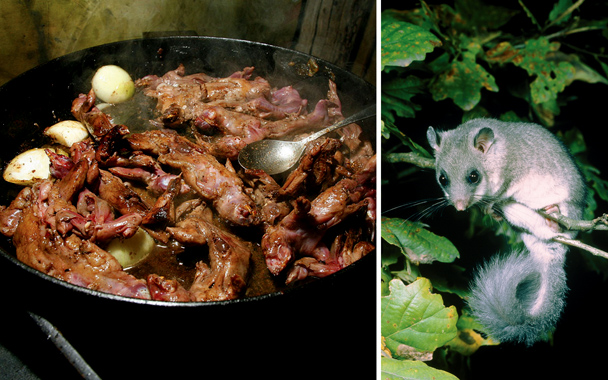With a cuisine that includes impressively diverse staple foods—game but also seafood; pasta as well as dumplings—Slovenia occupies an exciting culinary niche. The country’s location between Italy, Austria, Hungary, and Croatia helps explain much of this variation. But there’s also a certain time-warp quality to modern Slovenian cuisine, which includes meats that were once widely popular but have fallen out of favor elsewhere in Europe.
Take the dormouse, for example—a nocturnal rodent with a bushy tail that looks more like a squirrel than a mouse. A notorious delicacy of the Roman Empire mentioned in Petronius’ Satyricon (served dipped in honey), the dormouse remains a traditional food in Slovenia—particularly in the southern regions of Dolenska, Bela Krajina, and Notranska. Dormouse hunting season lasts from late September until the first snow, and each hunt is a ritualized event that involves setting traps and staying up all night. (Part of the appeal of this practice is the companionship of lying in wait and keeping warm with fortifying spirits; but there is a mythical significance, too: Local legend has it that the devil himself is a shepherd of dormice, so killing the rodents may historically have been seen as a way of battling evil.)
When it comes time to prepare the dormice, people employ a variety of cooking methods, but stewing them in red wine with vegetables is particularly popular. A more delicate recipe, from Traditional Slovenian Cooking (edited by Slavko Adamlje): “Cut the dormice into pieces, fry in butter or oil until golden brown, dust with flour and, after a few minutes more in the pan, add water. Put in cut potatoes, parsley, marjoram, peppercorns and lemon peel. Cover and simmer until done and add a little vinegar before serving.”
Sadly I wasn’t able to taste the animals on my trip to Slovenia (I went in June 2005, off season for dormice), but I did have a memorable lunch that involved another unusual protein. A culinary tradition for bear meat survives in Slovenia because it has one of the largest populations of brown bears in Europe, though in recent years the country’s hunting quota has provoked outcry from conservation groups. I discovered why the meat is so prized: The bear I ate, served in thin slices with fried yellow polenta, was delicious, with a deep gamy flavor, but it was lighter in color and texture than venison.
After our lunch the innkeeper told us we were lucky because the bear was younger than the normal legal age. It had been killed by a motorist, and because “the police know who to call in such cases,” we profited from an unfortunate accident. Not being a seeker after extreme gastronomy I felt a little strange, having my first bear and first acknowledged road-kill at the same time, but it was a wonderful meal.
We haven’t come across any recipes for dormouse in backissues of Gourmet, but we do have plenty of tips on how to handle the other varmints you may encounter.




 Pinterest
Pinterest


